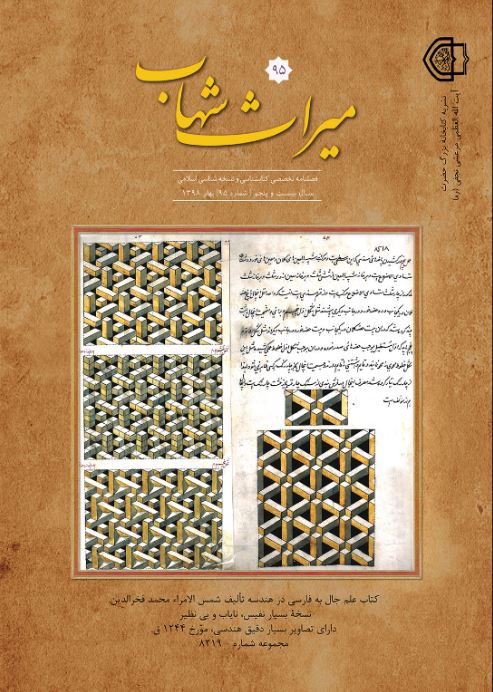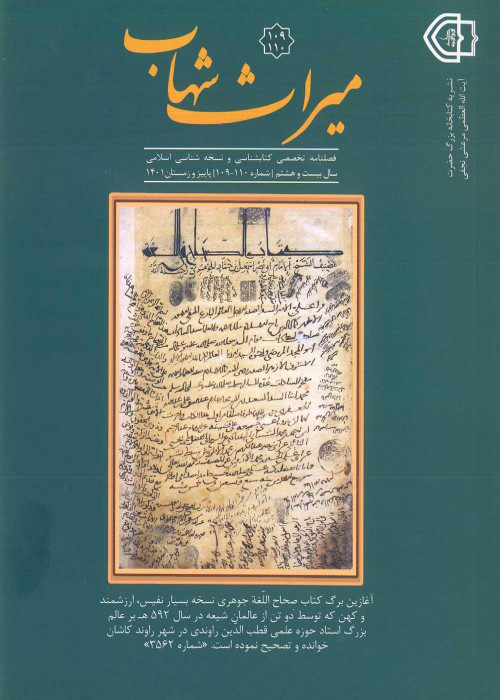فهرست مطالب

نشریه میراث شهاب
پیاپی 95 (بهار 1398)
- 256 صفحه،
- تاریخ انتشار: 1398/09/10
- تعداد عناوین: 8
- اسناد و مکتوبات
-
صفحه 3
- مقالات
-
صفحه 41
- شرح حال نگاری
- نسخه شناسی
- تصحیح متن
-
صفحه 169
- قم شناسی
-
صفحه 247
-
Page 3
This article is a collection of the letters written by ‘Alī Naqī Munzawī, the son of Shaikh Āghā Buzurg Tihrānī, to Āyatullāh Sayyid Shahāb al-Dīn Mar‘ashī Najafī and his responses to these letters. Most of these letters are related to the scientific endeavors of Shaikh Āghā Buzurg Tihrānī, especially the book Al-Dharī‘a, and sometimes to the personal problems or newly published books. These letters comprise part of the history of Ḥawzas and bibliographic studies of the 14th century. The introduction of the article reports on the multi-decade scientific relationships and efforts of Āyatullāh Mar‘ashī to identify, find, and revive ancient Shī‘a texts.
Keywords: Tihrānī, Āghā Buzurg, Munzawī, ‘Alī Naqī, Mar‘ashī Najafī, Sayyid Shahāb al-Dīn, Al-Dharī‘a ilā taṣānīf al-Shī‘a (book), Mar‘ashī libraryof Qom, Shī‘a Ḥawzas, 14th century scholars, Bibliography -
Page 41
This article mainly focuses on the points and novel findings about the status of the Shī‘a during the 9th and 10th centuries in the Old Bahrain, the quality of the interaction of the Twelver Shī‘a scholars with Safavid dynasty based on Shī‘a jurisprudential traditions, the importance of the consideration of this issue for the historical analysis of the Shī‘a communities, and the quality of the interaction of the Twelver Shī‘a scholars with Sunnī scholars, especially at the beginning of the Safavid era and before it. The evidences of the article are mainly the historical narrations and points taken from manuscripts along with their content analysis and criticism. Within these points, some information is mentioned about Sharaf al-Dīn ‘Alī Shūlastānī and his library, the dissimulation of Shī‘a officials in the ‘Abbāsī era, the licensing tradition and some evidences for it, various interpretations about Safavid dynasty from the viewpoint of the Twelver Shī‘a scholars, the writing of Nahj al-Balāgha manuscripts, Āl ‘Aythān and their manuscripts, the emigration of Qaṭīf scholars to India in the 10th century, the scientific legacy of the Old Bahrain in the 10th and 11th centuries, the role of the Shī‘a in the book Mu‘jam al-Buldān by Yāqūt Ḥamawī, Mongols’ invasion of Baghdād, the ancient qur’ānic texts in Ḥaḍrat Ma‘ṣūma (s) library of Qom, the name of the father of Qāḍī Nūrullāh Shūshtarī and Ḥākim Nayshābūrī.
Keywords: Manuscripts, Historical points, Bahrain history, Bahrain scholars, Shī‘a history, Safavid history, Shūlastānī, Sharaf al-Dīn ‘Alī, Dissimulation, Scientific licenses, Nahj al-Balāgha, Āl ‘Aythān, Qaṭīf scholars, Mu‘jam al-Buldān (book), Ḥaḍrat Ma‘ṣūma (s) library of Qom, Qāḍī Nūrullāh Shūshtarī, Ḥākim Nayshābūrī -
Page 107
Muḥammad Kāẓim b. Muḥammad Shafī‘ Hizār Jarībī Astar Ābādī
is one of the Shi‘a scholars of 13th century (AH), a contemporary of Zand
and Qājār. There are ambiguities about some aspects of his biography. These
ambiguities often result from the inaccurate and amateurish recording of the
biography of big figures and scholars by indexers and biography writers in
a way that sometimes due to similarity in names, books and dissertations of
scholars are attributed mistakenly to each other. In this article, six instances
of ambiguities about Muḥammad Kāẓim Hizār Jarībī are discussed and are
investigated, analyzed and clarified through the use of historical proofs and
documents.Keywords: Hizār Jarībī, Muḥammad Kāẓim, Muḥammad Shafī‘, History, rhythmic names on seals, correction, manuscripts, Shi‘a scholars of13th century (AH), History analysis -
Page 133
Under some subheadings, the author mentions some of the intentional damages done to manuscripts out of conflict towards books by anti-book individuals and provides some documents for each subheading: stolen, flawed, torn apart, coverless, untidy, indecisively endowed, forbidden and blacklisted, archaic, cheap, badly inherited and not inherited, captured. Then, he provides suggestions on how to use them.
Keywords: Manuscripts, Damages, Keeping manuscripts safe, Suggestions -
Page 155
This article is to identify a commentary written about Tahdhīb al-aḥkām, one of the main four Shī‘a Ḥadīth books, authored by Shaikh Muḥammad b. Ḥasan Ṭūsī, the well-known scholar of the fifth century (460 AH). This newly found commentary belongs to the 12th century, has been penned down in 1152 AH, and only regards the initial chapters of the book. The interpreter has been one of the pupils of Sayyid Ni‘matullāh Jazā’irī. The author of the present article extracts the characteristics of the commentary, its scientific references, and its manuscript-related features from the text of the book, and expresses two possibilities about the identity of its author.
Keywords: Tahdhīb al-aḥkām (book), Commentaries, 12th century Shī‘ascholars, Manuscript studies, Bibliography, Jazā’irī, Sayyid Ni‘matullāh -
Page 169
The text of Jandaqiyya ode entails what has been composed by Muḥammad ‘Alī Munshībāshī Danishwarī from Turbat Ḥaydariyya (1267- 1345 AH). This ode is a report on the Jandaq battle and Bāṣirī tribe in Khūr wa Biyābānak in 1337 AH. The author of the present article has provided an introduction on the biography of the poet, Bāṣirī tribe, the battle between the governor of Khurāsān with Ramaḍān Khān Bāṣirī, the overview of the ode manuscripts, and the editing style of the text.
Keywords: Jandaqiyya ode, Munshībāshī, Muḥammad ‘Alī, Khūr waBiyābānak, Iranian history in the 14th century, Jandaq battle, Bāṣirī, RamaḍānKhān -
Page 203
This article is about Ostad ῌasan Mi‘mār Qomī in the era of Qājār (circa 12271312- AH), one of the conspicuous architects of Qom that some people from his lineage also had the occupation of architecture. The author enumerates his architectural works, whether extant or destroyed, based on observing, interviewing, or using the print or manuscript references. Moreover, he mentions the works in which Ostad ῌasan, whether certainly or probably, participated. He describes Ostad’s other skills such as composing poems and assessing estates. Then the author elaborates on the Grand Arcade of Qom which is a remnant by the Ostad and belongs to years before 1285 AH and provides the whole text of his architectural couplets.
Keywords: Mi‘mār Qomī, ῌasan, Architecture of Qom, Qājār era, GrandArcade of Qom, architectural couplets


